#messier catalog
Text

A 4-hour integration of the Orion nebula in narrowband. Shot at 440mm with a 150mm Newtonian and a ZWO ASI533MM Pro.
Edited with PixInsight.
Integrated from:
12x600" Ha
12x600" Oiii
#astronomy#astrophotography#space#nebula#deep sky#narrowband#night sky#m42#messier catalog#orion nebula#shaystrophotography
71 notes
·
View notes
Text

FORBIDDEN TO REBLOG IN NSFW, 18+ (Porno, Naked/Erotic), AND also NOT in TRASH BLOGS, racism, politic, guns/wars blogs, thanks.
Messier 3 is a globular cluster in the constellation Canes Venatici. One of the largest and brightest, and is made up of around 500,000 stars. It is estimated to be 11.4 billion years old. It is centered at 32,600 light-years (10.0 kpc) away from Earth. Difficult to see with the naked eye, it starts to come to life in a large telescope. This image was taken by a fellow astronomer Robert The Space Guy and processed in Adobe by me, a shared venture. This cluster resides in our own galaxy.
#globular cluster#stars#space#colors#galactic#old#universe#telescopic#image#messier catalog#M3#Robert Wilmore#compact#night#telescope
24 notes
·
View notes
Text
One thing that (equivalente inglés de "me rompe las pelotas" no tengo ganas de traducir) me about modern astrologers is that it doesn't involve actual astral bodies anymore. Oooh, you made me a natal chart by reading a book or some website and gave me a personality test, who cares. Now, if you actually came to me and told me "I was watching the sky all night and I noticed a meteor passed by your sign" I might pay more attention to you.
Or maybe incorporate some of the new constellations here in the Southern Hemisphere. Who cares about Taurus or Aquarius, always with the Northern hemisphere, I want to see what Microscopium or Horologium means for my future (real constellations BTW). I haven't seen any astrologers talk about any constellations or celestial bodies besides the Zodiac and the solar system. I'm not sure if some of them even KNOW the Zodiac are actual stars that you can go outside and look. Come on, tell me what the Messier Catalog means for my love life.
Did you notice that the Tres Marías (Orion Belt) was up in the sky when Argentina won its third world cup? That's REAL astrology for me.
253 notes
·
View notes
Text

The debate over the correct Messier number for the Ship of Theseus is ongoing.
Messier Objects [Explained]
Transcript Under the Cut
[Multiple objects are labelled with M followed by a number.]
[There is a tree, a butterfly, a squirrel, a man with a powdered wig labeled Charles Messier, a squirrel, and ground.]
M137 (Earth) (pointing to the ground)
M205 (Charles Messier) (pointing to Charles Messier)
M21860 (pointing to a tree on the left of the panel)
M41592 (pointing to a butterfly above Charles)
M30712050 (pointing to a squirrel)
[Caption below the panel:] People usually focus on the first 110, but the Messier Catalog actually includes all objects.
319 notes
·
View notes
Photo
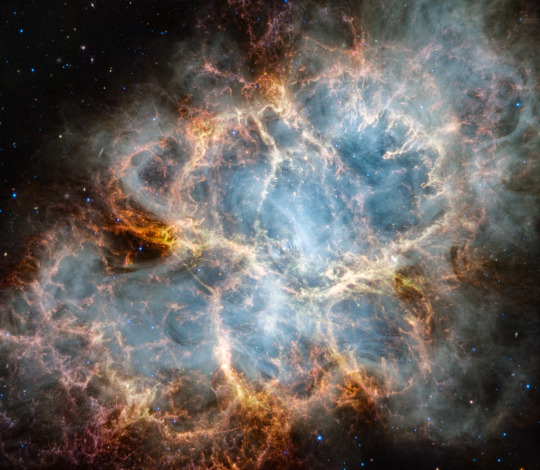
2023 November 9
M1: The Crab Nebula
Image Credit: NASA, ESA, CSA, STScI; Tea Temim (Princeton University)
Explanation: The Crab Nebula is cataloged as M1, the first object on Charles Messier's famous 18th century list of things which are not comets. In fact, the Crab is now known to be a supernova remnant, debris from the death explosion of a massive star witnessed by astronomers in the year 1054. This sharp image from the James Webb Space Telescope’s NIRCam (Near-Infrared Camera) and MIRI (Mid-Infrared Instrument) explores the eerie glow and fragmented strands of the still expanding cloud of interstellar debris in infrared light. One of the most exotic objects known to modern astronomers, the Crab Pulsar, a neutron star spinning 30 times a second, is visible as a bright spot near the nebula's center. Like a cosmic dynamo, this collapsed remnant of the stellar core powers the Crab's emission across the electromagnetic spectrum. Spanning about 12 light-years, the Crab Nebula is a mere 6,500 light-years away in the head-strong constellation Taurus.
∞ Source: apod.nasa.gov/apod/ap231109.html
199 notes
·
View notes
Text

The Surfboard Galaxy (M108, upper right) and the Owl Nebula (M97, lower left) // David Cheng
Located near the Owl Nebula (M97) on the sky, the Surfboard Galaxy was discovered by Méchain in 1781, only three nights after he found M97. Messier himself observed it about a month later, although he didn't measure its position and so did not include it in his catalog.
William Herschel (1738-1822) independently discovered it in 1789. It wasn't until 1953 when American astronomer Owen Gingerich (1930-2023) identified it as M108.
#astronomy#astrophotography#messier marathon#galaxy#spiral galaxy#barred spiral galaxy#star-forming galaxy#nebula#emission nebula#planetary nebula#surfboard galaxy#owl nebula#messier#messier 108#M108#messier 97#M97#NGC 3587#NGC 3556#ursa major
99 notes
·
View notes
Photo

M44: The Beehive Cluster : A mere 600 light-years away, M44 is one of the closest star clusters to our solar system. Also known as the Praesepe or the Beehive cluster its stars are young though, about 600 million years old compared to our Sun's 4.5 billion years. Based on similar ages and motion through space, M44 and the even closer Hyades star cluster in Taurus are thought to have been born together in the same large molecular cloud. An open cluster spanning some 15 light-years, M44 holds 1,000 stars or so and covers about 3 full moons (1.5 degrees) on the sky in the constellation Cancer. Visible to the unaided eye, M44 has been recognized since antiquity. Described as a faint cloud or celestial mist long before being included as the 44th entry in Charles Messier's 18th century catalog, the cluster was not resolved into its individual stars until telescopes were available. A popular target for modern, binocular-equipped sky gazers, the cluster's few yellowish tinted, cool, red giants are scattered through the field of its brighter hot blue main sequence stars in this telescopic group snapshot. Dramatic diffraction spikes highlighting the brighter cluster members were created with string crossed in front of the telescope's objective lens. via NASA
744 notes
·
View notes
Photo
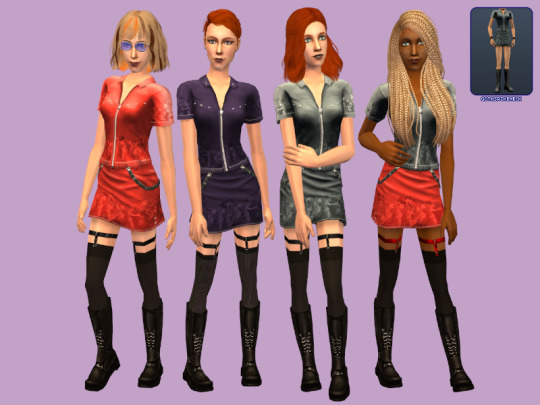


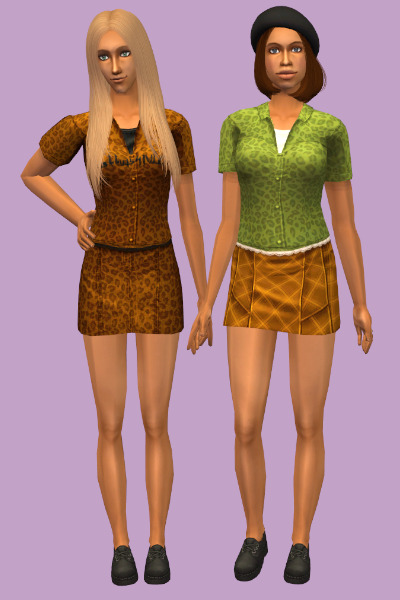
Hello. I made even messier defaults.
tfbodygothspikeneck and tfbodyhipbootiscool replaced with basically this, except I redid the meshes a little. They now use the same mesh, but with different active groups for boots or shoes. I also restored the goth accessories because people seemed to want them, and I made them alpha editable. Get zzBins_gothspikeneck_redblack_rudhira from here if you want the redblack recolour of gothspikeneck to appear next to the other ones in catalog.
I made two versions, v1 which is basically the old version (and shown in the teen preview), and v2 which is partially texture referenced to the original, and has no leg accessories. I would only recommend the latter if you want texture defaults, as two recolours of gothspikeneck are identical otherwise.
I ALSO made an adult conversion. They’re shown in v2 and with these texture defaults by @katsurinssims, but will use whatever textures you get for teens. Get the version labelled ADDONS if you want the adult files, bundled with the teen defaults.
Download gothspikeneck! - swatch v1, swatch v2
Download hipbootiscool! - swatch v1, swatch v2
And because this wasn’t complicated enough, I also made files with both replacements bundled to save space. Make sure you get the correct one.
Download gothspikeneck & hipbootiscool!
#sims 2#s2cc#default replacement#default: clothes#default: female clothes#yeah uh this was a ride and a half
143 notes
·
View notes
Text

Observing The Beautiful 💫 ANDROMEDA CONSTELLATION in Space
#shorts #andromeda #constellation #space
To Watch The Video of Observing The Andromeda Constellation visit my Youtube Channel @InfinityASTRONOMERICA
About the Video :
The Andromeda constellation consists of 16 stars visible in the northern sky. Named by ancient Greeks after the mythological Andromeda princess, the constellation contains the Andromeda Galaxy, the nearest full-fledged galaxy to our own Milky Way.
It is a barred spiral galaxy and is the nearest major galaxy to the Milky Way. It was originally named the Andromeda Nebula and is cataloged as Messier 31, M31, and NGC 224. Andromeda has a diameter of about 46.56 kiloparsecs (152,000 light-years) and is approximately 765 kpc (2.5 million light-years) from Earth. The galaxy's name stems from the area of Earth's sky in which it appears, the constellation of Andromeda, which itself is named after the princess who was the wife of Perseus in Greek mythology.
#science#Andromeda Constellation#andromeda galaxy#spirituality#technology#tumblr milestone#hubble telescope#outer space#space photography#astronomical object#astronomy#astrophysics#nasa webb telescope#hubble space telescope#telescope#james webb telescope#james webb space telescope#space telescopes#space#spaceship#nasa#nasawebb#isromissions#isro#isroindia#constellation#nature#positivity#quotes#InfinityASTRONOMERICA
100 notes
·
View notes
Text
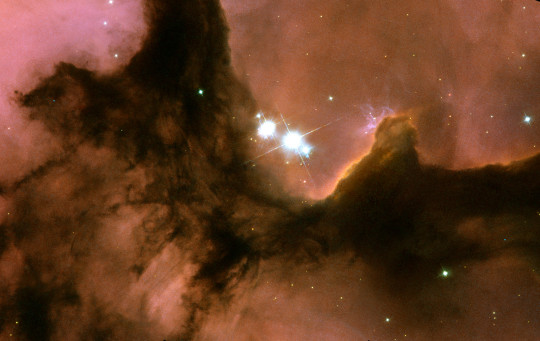
The Trifid Nebula, cataloged by astronomers as Messier 20 or NGC 6514, is a well-known region of star formation lying within our own Milky Way Galaxy. It is called the Trifid because the nebula is overlain by three bands of obscuring interstellar dust, giving it a trisected appearance as seen in small telescopes. The Trifid lies about 9,000 light-years (2,700 parsecs) from Earth, in the direction of the constellation Sagittarius.
Credit: NASA, ESA, and The Hubble Heritage Team (AURA/STScI)
729 notes
·
View notes
Text
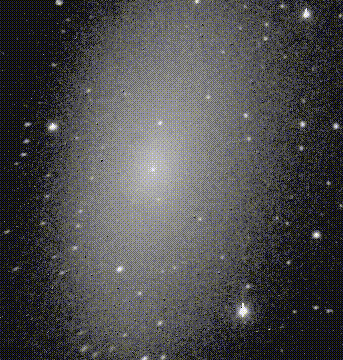
Local Group Galaxy NGC 205 - January 8th, 1996.
"The Milky Way galaxy is not alone. It is part of a gathering of about 25 galaxies known as the Local Group. Members include the Great Andromeda Galaxy (M31), M32, M33, the Large Magellanic Clouds, the Small Magellanic Clouds, Dwingeloo 1, several small irregular galaxies, and many dwarf elliptical galaxies. Pictured is one of the many dwarf ellipticals: NGC 205. Like M32, NGC 205 is a companion to the large M31, and can sometimes be seen to the south of M31's center in photographs. The above image shows this galaxy to be unusual for an elliptical galaxy, in that it contains at least two dust clouds (at 7 and 11 o'clock - they are visible but hard to spot) and signs of recent star formation. This galaxy is sometimes known as M110, although it was actually not part of Messier's original catalog."
43 notes
·
View notes
Text
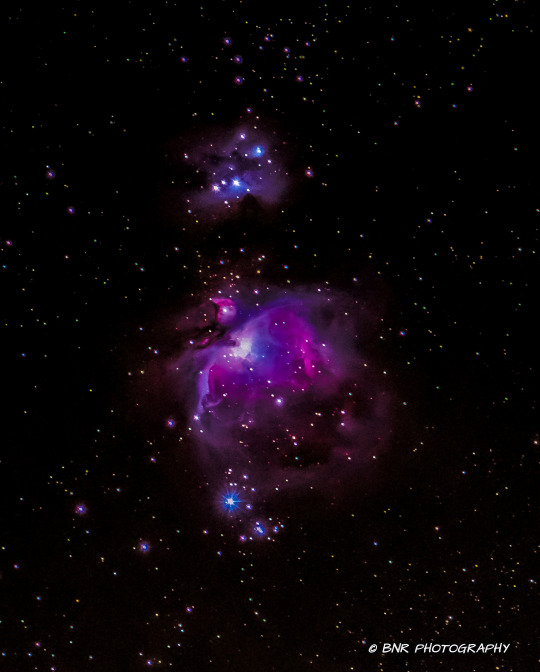
FORBIDDEN TO REBLOG IN NSFW, 18+ (Porno, Naked/Erotic), AND also NOT in TRASH BLOGS, racism, politic, guns/wars blogs, thanks.
The famous Great Nebula in Orion in the center and the Running Man Nebula at the top. RAW imaging stacked in Deep Sky Stacker and then processed in Adobe and LR. 250 images comprised to make this image.
#astronomy#galaxy#nebula#stars#space#night#telescope#time exposures#M42#gas#Orion#constellation#winter#copyright#colors#Messier object#catalog#star formation
71 notes
·
View notes
Text

_____________________________________________________________
It has taken me two years to complete the entire Messier catalog.
Now we have it here!
From the balcony without seeing Polaris and from a Bortle 8/9.
I am finally very happy and grateful to all those who have helped me or shared some moment along the way.
Love,
Montse Coll (Montcada i Reixac, Barcelona)
xx
#astrophotography#urban astrophotography#astrophotos#astro observations#cosmos#original photographers#astronomy#universe#original photographic works#cataloguemessier#charles messier
44 notes
·
View notes
Text
mental heath stuff (not bad just candid)
dunno if i'll regret sharing this just yet, maybe i should have sat on it a little more until i knew exactly if i should share and how much, but parts of me really insist, and so i guess we're going for it
and i word that way because
months of exhausting processing has led me to conclude that I’m a system, so I’m still in the undertaking of cataloging an awful lot of shit into one rolodex. the kicker is i probably have been one for at least 20 years, but everyone got along so well and so cooperatively, like the most well harmonized combining mecha, that is oblivious to the fact it even is one. nobody even needed nametags in here.
…mostly. warning signs were there, it's just some of the issues that come from this sort of thing that did leak through, were hiding under other conditions that already cause similar complications. if you're familiar with the messier mental illnesses and all the ways they start to functionally melt at the edges and trade symptoms in odd places and our understanding of it all is still so half-formed,
you'll probably get what i mean.
hopefully people following me understand none of this crap works like it tends to get depicted in media
i'm schizophrenic and my mind is a fucking enigma anyway
anyway
then one "new" alter woke up last november in response to an acute straw breaking camel's back moment of abuse at home after enduring way too much for way too long, but the alter is not actually new, is technically one of the oldest, but she's been 'asleep' for like a decade and her point of origin is even older than that
obviously this one was SO different and possessed SUCH a different headspace and set of tastes and desired behaviors, and subsequently threw equilibrium off so badly, all the components of the mecha suddenly realized they were components bc now the situation kind of required acknowledging that fact to proceed to even get starting fixing shit.
its like
"who is this weird one who broke everything"
"no clue, you guys got any ideas?"
"why would we have any ideas you don't, we're all us"
"yeah like what do you even mean by You Guys?"
"i think they're joking, like, because we're all copies of the same person, like the spongebob bit with the fine dining, they're asking themself rhetorically because it's funny……..
…….we are all the same person right. this is a metaphor. like the spongebob bit…… right….."
"why are we not all immediately agreeing"
"because before we could all reflexively say yes we realized we all had different definitions of The Same Person we are"
this is a gross oversimplification of course
this was a lot to process for pretty much all parts of me save one (incidentally, not the new one, the new one isn't shocked, but is a crybaby, so they didn't take Existing (Again) (2. Electric Boogaloo) very well. they do not take the prospect of 'going back to sleep' veryy either, though. so we're having to slightly redesign the mecha)
mostly through the worst of it, but among other problems we're still working to repair, this sleeper code alter caused a catastrophic system failure in the ventilation and even though everyone is mostly calmed down now, they can still smell everyone else's scented candles in their personal quarters, which is annoying when some of them have VERY different tastes in scents)
annoying, but not ruinous.
fixing the AC is low priority compared to other things
like the pneumonic tube that used to let everyone hot potato information and memories from any time they were the one obliviously in the cockpit, we had a pretty damn good one, it was working so well we didn't know why we were even using it, and assumed its regular but manageable failings were just, natural, or because of some other factor affecting the tubes themselves or potato availability, and not considering most people do not have these potato tubes at all
yes i will probably make some kind of comic to conceptualize and visually externalize this i struggle to feel understood without doodles
also, while typing this post, specifically, tumblr did a fucky wucky, and when i realized i'd made an entire other post in the tags, i went to try to copy/paste them into the post but the nature of the fucky wucky prevented this. i'm really not in the mood to retype all that so it's just a screenshot now

#sporadic warbling#the good news the venn diagram between us all in terms of what we believe in and whats okay to do or not n shit mostly lines up#tho the scented candles thing is actually less trivial than it sounds / impacts QoL more than i'm willing to get into rn but we live#also the memory thing but my memory was bad before and after the fact#its taking so long to fix the potato pipes and i'm tired of manual potato delivery so i'm entering my Fuck the Potatoes era#like well kids i had a presentation prepared but the overhead's broken and i could make you do a worksheet instead#but why not let you just go play outside while the janitor and i fix the overhead. it's not fair the principle took away recess anyway.
58 notes
·
View notes
Photo

2023 November 15
M1: The Incredible Expanding Crab
Image Credit: NASA, ESA, CSA, STScI; Jeff Hester (ASU), Allison Loll (ASU), Tea Temim (Princeton University)
Explanation: Cataloged as M1, the Crab Nebula is the first on Charles Messier's famous list of things which are not comets. In fact, the Crab Nebula is now known to be a supernova remnant, an expanding cloud of debris from the death explosion of a massive star. The violent birth of the Crab was witnessed by astronomers in the year 1054. Roughly 10 light-years across, the nebula is still expanding at a rate of about 1,500 kilometers per second. You can see the expansion by comparing these sharp images from the Hubble Space Telescope and James Webb Space Telescope. The Crab's dynamic, fragmented filaments were captured in visible light by Hubble in 2005 and Webb in infrared light in 2023. This cosmic crustacean lies about 6,500 light-years away in the constellation Taurus.
∞ Source: apod.nasa.gov/apod/ap231115.html
150 notes
·
View notes
Text

The Orion Nebula, M42 // Felix Mahncke
The famous Orion Nebula is the 42nd entry to Messier's catalog. Visible to the unaided eye as a fuzzy patch just below Orion's belt, the discovery of the nebula is generally credited to Nicolas-Claude Fabri de Peiresc (1580-1637) who found it in 1610. The bright part of Orion stretches across 24 light years and has 2,000 times the mass of the Sun.
#astronomy#astrophotography#messier marathon#nebula#emission nebula#star-forming region#orion nebula#messier#messier 42#M42#NGC 1976#Sh2-281#orion
89 notes
·
View notes